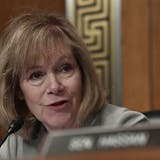Gov. Mark Dayton unveiled a dramatically scaled-back budget proposal Tuesday, abandoning his longtime effort to bring state-paid preschool to Minnesota as he tries to ensure the state's fiscal stability for years to come.
The governor's reduced spending priorities came as a result of new warnings about a potential economic slowdown that could drag the state into deficit in coming years.
Dayton said he would only pay for urgent spending priorities and is determined to beat back ongoing spending proposals that could blow a hole in future budgets.
"We need to be very cautious in what we obligate in tax cuts and spending increases," Dayton said. "I'd rather spend money on other priorities, but these are urgent and absolutely necessary."
Dayton wants to set aside $100 million for expanded high-speed Internet access in rural Minnesota and another $100 million to address racial inequities, following what he called alarming reports showing dramatically higher levels of poverty for black Minnesotans. The governor also is seeking $117 million in various tax cuts for education expenses and working families, which his office estimates would help about 400,000 Minnesota families.
All told, the governor wants $700 million in new spending, including the tax cuts, which must be booked in the state budget as new spending. That leaves about $202 million on the bottom line as financial cushion for the two-year budget cycle, based on the new statewide budget forecast. Dayton also highlighted a record-level rainy day fund and cash-flow account that now stands at about $1.9 billion.
Dayton's budget proposal will serve as a financial outline for this legislative session. Legislators and interest groups are already lining up with a long list of ways they'd like to spend the $900 million projected surplus, decisions made more difficult in an election year when all 201 seats are up for grabs.
Proposals already are in the works for deeper tax cuts, capital improvement projects around the state and a comprehensive transportation package to pay for roads, bridges and transit.


